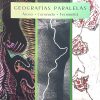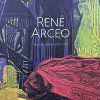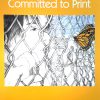by Jose Agustin Andreu
In my youth, I heard an indigenous man explain that each of us has several names; the name they give you at birth, your family name, and your actual name, which you discover when mature. He pointed at a squirrel and said, “That animal has the name we give it, her name amongst its kind, and a name only she knows and keeps to itself.”
Being human requires us to assume several levels of identity as we interact within ever more complex circles of relationships. As individuals, each of us is a member of many intersecting communities or groups. From the nuclear family to the extended one, neighborhood associations, work, school, church, sports fans, amateur interests, city, state, national, ethnic, cultural, military, shared history, and shared trauma. Each supplies us with a relationship and a definition of identity.
Many Latino immigrants endure similar stresses in migrating to the USA. Rene Arceo has a complex background and brings a history of relationships and self-definitions, having been born in the town of Cojumatlan, in the Mexican state of Michoacan. From that moment, the artist wears an expanding set of personal, familial, neighborhood, regional, and national identities to which are added Chicago and the USA.
But once in the USA, there is an added complexity confounded by the terms Hispanic and Latino and those beyond Mexican, such as Chicano, Tejano, Californio. Those are assignations of Mexican-American cultures developed within the now United States territory. They were essential American cultures before military conquest, colonization, and financial transactions brought them into the USA through unilateral and broken treaties. Spanish was spoken in U.S. territory over 250 years before English, hence the familiar refrain in some border communities, “We didn’t cross the border; the border crossed us.” And, as was written by Octavio Paz,” To give a name to a community is not to invent it, but to recognize it.”
You cannot reduce Hispanic culture to the Counter-Reformation and its resistance to modernity. The religious wars of the Reformation helped fine-tune Spain’s war machine. They unknowingly prepared Spain for the conquests of the new world. The culture that conquered America wants to be and should be defined by its legacy, art, architecture, literature, music, and mystical poetry. Yet its character is also full of genocidal actions and repressions, such as the expulsion of Jews and Muslims. How many migrant surnames in the conquered territories had Jewish, Mozarabic, and Arabic roots? Many had reasons to migrate to conquered territories, and many migrants became disregarded, overlooked, and neglected. The other heritages included in the current definitions of Latino/Hispanic are equally complex, African and Indigenous. Those contain terrible truths, conquest, slavery, servitude, loss of myths, languages, and gods, the genocide, voluntary or involuntary, of Indigenous bodies and cultural identity. It’s sinful to forget one’s identity through neglect or ignorance, but when they beat it out of you, it’s a crime against humanity.
When a migrant from Mexico travels into USA territory, they bring this complex layering of cultures. Even stating that Rene Hugo Arceo comes from Cojumatlan, Michoacan doesn’t clarify the complexity. The Mexicas were not the largest population in Michoacan, the ethnic group to which the Aztecs belong and from where the name Mexico derives. In Michoacán, the largest group of people were the Purépecha. They, too, were from the Nahuatl language group and had an empire around Lake Patzcuaro that rivaled the Aztec empire but were never conquered by them. The Purépecha are descendants of the late arrival of Chichimeca, who came from the north. Historically, the dominant culture wants the subjugated culture to forget theirs and assimilate in a natural inclination towards homogeneity and unity. The conflicts that we experience between class and race as Latinos can happen even within one’s own family.
Rene shares this complexity of backgrounds with many migrants from Mexico, Central, and South America. He also shares a culture with other immigrants, Cubans, Puerto Ricans, Dominicans. What is extraordinary isn’t the diversity of Latin groups and the differences among them but the great cohesion, a unity not expressed politically but in collective acts and attitudes. North American society values the individual. The preeminence of the individual as a central value comes from the Reformation and the Enlightenment. Latino society is communal and, although traditionally patriarchal politically, its nucleus is the family around the mother.
What should we call the various Latin-American communities in the U.S.—the Chicanos, Puerto Ricans, Cubans, Central and South Americans? The most common term Latino covers all of them in their complex unity. When Rene Hugo Arceo says he is Latino, it is not a simplistic statement but an aggregation of history and culture, his cultural DNA. As a mestizo, he represents the fifth race as stated by Jose Vasconcelos, and an evolutionary step towards the new Cosmic Race.
The North American art canon and the nationalist paradigms that dominate Latin American art ignore Latino/a artists. This exclusion continues despite historical efforts by Chicano/a, Nuyorican, and Latino/a art movements and its advocates to challenge it by creating culturally specific art spaces and museums. The Black Lives Matter movement has elicited discussions of structural racism in everyday society. Students and artists are challenging the racist legacy of universities and the mantle of high culture in which they are vested. We continue to confront the history and mechanics of racism in the arts. This racism diminishes artists of color and their work to clichés and the rubric of identity politics. It has entitled curators and critics to talk about Latino art and artists of color without knowing their vocabularies, aesthetic traditions, and backgrounds.
Latino artists work in a variety of media and have a variety of ways of expressing their identity and culture. Nevertheless, they create under the intimidation of ethnographic interpretation of their work and exist under the shadow of their modernist predecessors. We can explore the commonalities and differences in their self-representations. Yet, no visual representation of people of color is ever innocent or powerful enough to challenge the socially defined images that frame them as marginal, as threats, as foreigners, as others, as having too much culture or too little culture. By themselves, artistic representations can do little to challenge racism. It takes structural change to create a visual revolution that can entirely change and destroy our preconceptions.
Culture is the battleground where many of these conflicts reveal themselves. Creative individuals in all cultures help update and clarify a community’s relationship with terms such as ‘Culture’ and ‘Art.’ Still, we do not fully understand how deeply they have a meaning or their interrelation. Philosophers, political scientists, educationists, and many others have studied culture. The ancient Greeks associated culture with good breeding, education, and love for the land. All cultures have a system of signs, symbols, and stories that shape our perceptions, myths that shape our thought and behavior. Some myths keep the world running; others can be deeply problematic. They can help us define our space in a complex and contested world. To realize that they shape our thinking and our behavior is perhaps a kind of freedom.
An artist’s awareness of his own belonging to a community, allowing him to understand his place in the socio-cultural space and freely navigate the world around him, is integral with the concept of cultural identity. In a modern society where globalization continues to deepen, continuous contact between individuals from different cultural backgrounds will trigger thinking about cultural identity. It is the cornerstone of personal and national identity. The perspective of developmental psychology emphasizes that the construction and formation of individual cultural identity is a complex process of change. Social identity theory focuses on the relationship between cultural identity and self-esteem. A solid and safe national identity will promote the improvement of individual self-esteem.
Today artists continue a tradition of reimagining and reincorporating symbols of pre-colonial authority into the spirit of their national heritage. Images of indigenous, mythological figures and depictions of everyday life permeate contemporary art. Rene Hugo Arceo presents Indigenous deities that entertain regardless of one’s knowledge of Mesoamerican mythology. Arceo’s emotion transcends a strict interpretation based on an artist’s ethnographic reference. We are drawn to the story by Arceo’s gesture, humor, and personal narrative. By manipulating the shadow cast over one’s work by popular culture and art history, the artist redirects focus back onto the individual and again opens up the dialogue to reflect on a more personal search for identity.
Latino artists present a merged identity from two or more cultures in actions that are continually more relevant to our time. This syncretism can keep one from finding the complex authenticity in the most culturally diverse people. From the German-Mexican Kahlo, the Chinese, Afro-Cuban Lam, each Latin American artist deserves the chance to share the story of their distinctly personal identity and the respect from audiences to view it just like that, personal. Instead of continuing the practice of hiding beneath a superficial exotic image established by their colonial rulers, Latino artists push forward an agenda where their unique and diverse worlds are shown as they are for all to appreciate.
African masks in European museums, so beloved by the Cubists, lose their essence and purpose in life, placing them somewhere where their use has changed. Picasso recognized their expressive power but did not understand their religious context. The original sculptors were not making fine art, as we know it; they were making real their tribal religion. Taking an object from one place and bringing it to another strips them of their essence, but being left empty of their original intent can be something positive. In contemporary culture, it then represents the artists themselves.
Latino artists may all have different backgrounds and hold different heritages. Their works are hybrids like themselves, a body of chaos and difference all mixed in together. They have found a way to speak about this wreckage. They have used art as a tool and brought what is inside them out for the world to view. Culture then becomes a weapon to help attain self-esteem and empowerment. The searching for cultural identity and self-identity is an ongoing process and making art helps them connect to their identities. Minority artists allow forbidden and forgotten images to surface, reinforcing aspects of identity that provide pride and self-esteem. Art enables artists to see the larger meaning of their life experiences.
Hybrid experiences and improvisation are a significant aesthetic factor in Rene’s art. Making art is not simply expressing the self but is a far broader and essential task that involves expressing oneself as a member of a larger unity or community. So that in speaking for oneself, one is also speaking for those who cannot speak. Artists of mixed backgrounds who represent this in their works are always standing in two places at once. That space is where everything comes together, their history, heritage, and everything that comes into contact and holds value to them. That is what makes results so strong, the forced merging. What doesn’t stand in one place but two or more is free. It’s a freedom to wander off to unknown territories. The use of random improvisation can be described as uncompromising and reflecting a unique experience.
By speaking out, formerly victimized individuals reclaim their humanity and empower themselves by giving new meaning to their own particular experiences. Artists can’t change the world alone, but art is a powerful and potential subversive tool of consciousness. Using imagination and the principles of freedom, equity, and equality, the Latino artist can inspire the viewers’ courage to transform. Individuals can learn to see their lives in political terms. Raising consciousness emerges as central to the idea that “the personal is political.” It is an essential tool for unmasking prejudice and securing justice and the freedom to act and choose the capacity to become different. Art mobilizes people for struggle and establishes that “the political is personal.”
The term identity is the reflective self-conception or self-image that we each desire from our cultural, ethnic, and gender socialization process. Individuals develop distinctive personal identities because of unique life histories, experiences, and personality traits. In the process of making adjustments and transitions, immigrants experience significant changes in their lives as they reshape their sense of self-identity in America. Through the art-making process and personal art expression, they gain a voice, self-knowledge, and a sense of self. The formation of cultural identity, in turn, affects personal identity. Achieved ethnic identity contributes positively to self-esteem, which is a critical feature of the self-identity of ethnic minorities.
Art as a political act can play an instrumental role in personal and social transformation. The inner desire to reconstruct a sense of self, with a passion for social justice, equity, freedom, and hope, is put into action through art. Art is the vehicle for self-development, self-identity formation, and a means to examine one’s individual and cultural identity. Artists function as essential links among local communities, schools, museums, and art institutions. These artists fulfill the role of cross-cultural critics, educators, and ambassadors between communities in America, national communities in the Americas, and the broader global community. Artists such as Rene Arceo are role models as cultural activists, educators, art community leaders, and consciousness-raising organizers who help others reevaluate society from multiple perspectives.
What is the role of the artist? Create, make art, don’t overthink. By expanding options through their authentic selves, artists create wealth. They make a vocabulary, words, images, sounds to help us see that with which we are unfamiliar. Artists help us to open ourselves to other individuals, to different cultures. Artists, poets, and musicians create the means to make visual what is hidden. They give us the means and tools to understand and reach another culture effectively. We need to be interested and sensitive to notice cultural differences in order to modify our behavior as an indication of cultural respect. In the words of photographer Diane Arbus, “There are and have been and will be an infinite number of things on earth, individuals, all different, all wanting different things, all looking different. Everything that has been on earth has been different from every other thing. That is what I love: the differences, the uniqueness of all things, and the importance of life; I see something that seems wonderful; I see the divineness in ordinary things.” Through his work, Rene Hugo Arceo has left the means to help us write the story of our time. He has defined our cultural identity by revealing the orbit of his own soul.
October 2021




